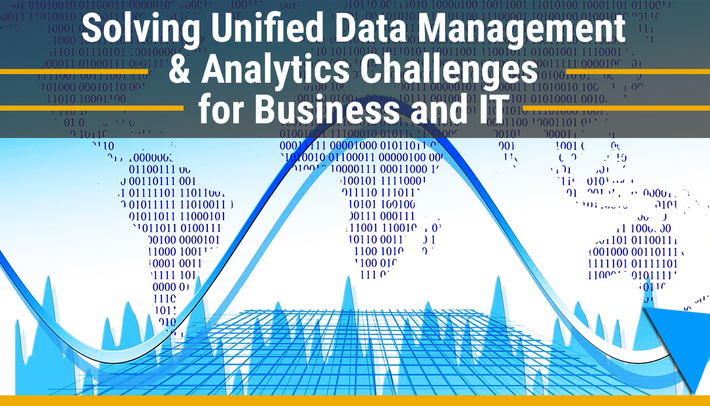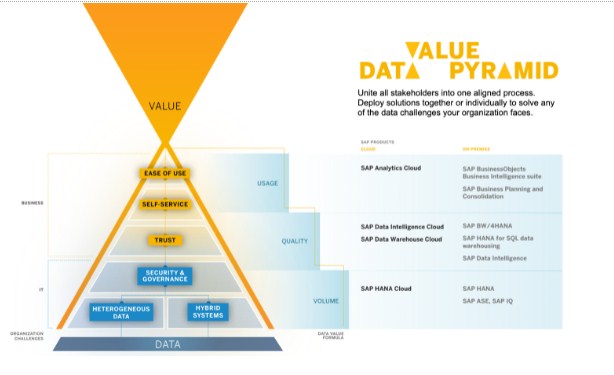
Organizations in every industry are leveraging data and analytics to overcome roadblocks on the path to innovation and progress, plan for the future, and position their organization to competitive advantage.
The entire enterprise must become more connected than ever before for expertise to come together to drive a shared vision for innovative change. This means transitioning away from legacy systems and adopting a modern approach to business processes and operations, and data and analytics.
Ronald van Loon is an SAP partner, and as an industry analyst and insider for over twenty years, has an opportunity to further investigate the challenges emerging in the unified data and analytics domain.
To get the most value from data, businesses need to strengthen their data culture, and this continues to be an evasive objective for numerous organizations. With so many new systems, processes, and individual ways of thinking and working, creating a connected data ecosystem can be complex.
But with a unified data management and analytics solution, the world of business and IT can unite to drive data initiatives forward, enhance productivity, and overcome the unique challenges that are inherent to business and IT.
Data and Analytics Complexities Grow
Data is unquestionably increasing in value, but its simultaneously growing in complexity. Organizations have to tackle this complexity in order to benefit from the potential value of data. But traditional approaches to database, data warehousing, and analytics can take years of development and deployment before they produce any benefits, and even then, companies can face limitations when pertaining to real-time analytics, complex data sets, and data streaming.
Businesses are also reporting that theyre grappling with advancing and managing data as a business asset, driving a data culture, accelerating innovation via data, and using data and analytics to compete. 29.2% of businesses report having accomplished transformational business results, 30% report having built a meaningful data strategy, and only 24% believe their company was data-driven this last year.
A few of the primary challenges impeding analytics progress include:
- Lack of a strong analytics strategy, which may encompass under-utilized technologies, failing to set manageable goals that can provide quantifiable value, or lack of interaction and agility across data, IT, and business.
- Unbalanced analytics programs that dont account for diverse user needs as well as enterprise-wide standards, which can result in inefficiency and prevent analytics from being scaled.
- Insufficient data governance and data hygiene that impacts data accessibility and often leads to data silos.
- Myriad data sources, overlap, and obscurity due to the adoption of new processes and systems throughout numerous layers of the organization.
- Legacy analytics initiatives that hinder organizations from developing, deploying, and scaling advanced analytics due to deficient features for collaboration, and limited artificial intelligence (AI), machine learning (ML), and big data capabilities.
Companies can be further challenged in infusing data into the very DNA of their decision-making processes rather than just understanding or discussing the importance of including it. Ultimately, this puts a damper on creativity, curiosity, and an enterprise-wide data mindset that fosters dynamic, smart innovation across products and services.
Business leaders need to approach data and analytics investments as an accelerant to ongoing business requirements, develop analytics capabilities according to relevant use cases and business problems, and build upon this foundation by strategically implementing new tools, technologies, and solutions.
Business and IT Unified Data Management and Analytics Challenges
As data is one of the most powerful and critical assets an organization has, it must be available, accessible, and able to be leveraged by every user across the entire value chain. Business users have to be able to ask questions and get answers from their data and rely on it as a pillar of decision-making. This extends to both IT and business lines, though these two areas have distinctive roles, responsibilities, and purposes.
If business and IT can work together and share their knowledge and experience when it comes to data, progress can be optimized across the enterprise. But business and IT have their own set of unified data management and analytics challenges that they face that they need to overcome.
Business challenges:
- Trusted Data: Lacking quality data, outdated data, or duplicate data.
- Self-service: Overly complex systems and processes create barriers for business units who need simplified methods to get to the data that they need to make decisions.
- Ease of use: Having the capabilities to work independently and access the data that they want without contacting and/or burdening IT teams.
IT challenges:
- Hybrid Systems: Working on premise or in the cloud can be time consuming and overly complex.
- Heterogeneous Data: Siloed data from multiple sources is too spread out.
- Security and Governance: The evolving landscape of security, privacy and regulatory environments are becoming complicated.
When business and IT teams cant effectively use data, they cant work freely, make confident decisions, and leverage artificial intelligence (AI) and machine learning (ML) to help them transform data into solutions and meet the demands of evolving consumer behaviors, rapid transformation, and technological enabled workspaces.

An Answer to Business and IT Challenges
Organizations need flexibility, agility, and connectivity in order to enhance collaboration and use data-driven insights to drive intelligent solutions forward. With a unified data management and analytics strategy, organizations can overcome the common challenges that business and IT are facing across industries.
SAP Unified Data and Analytics connects business and IT professionals and improves end-to-end data management to simplify data environments and help organizations grasp and maximize the true value of their data to its fullest potential.
In order to develop a unified data ecosystem, organizations are moving to cloud database as-a-service solutions, using an intelligent platform like the SAP Business Technology Platform that connects disjointed data from IoT, cloud and big data, creating a single source of truth. This helps businesses resolve data trust challenges and simplify IT disparate data and hybrid system complexities. At the same time, IT can better focus their attention on governance and model data in secure spaces. Data and workloads essentially become more integrated and connected, which helps business and IT better collaborate.
With intelligent cloud solutions, like SAP HANA Cloud, SAP Data Warehouse Cloud, SAP Data Intelligence Cloud, and SAP Analytics Cloud, organizations can choose what data to keep on premise and which to keep in the cloud, scaling as needed, migrating legacy systems where necessary, and start the process of building a modern infrastructure. Organizations can give data purpose with SAP Unified Data and Analytics.
An intelligent platform is going to simplify data accessibility for business teams while simultaneously providing visualizations and dashboards. This brings real-time data insights to life, enabling business teams to establish a meaningful connection to their insights, which solves the previously discussed decision-making and accessibility challenges.
Unified Data Management and Analytics Optimization
Eliminating unified data management and analytics challenges ensures that organizations are able to deploy their forecasts, contextualize data and analytics, and share insights across business and IT to continuously grow and innovate.
To learn more and stay current with the latest data and analytics trends and information, you can visit the executive corner industry pages with a focus on retail, public sector, or consumer packaged goods on saphanajourney.com or sign up for the SAP Data Defined: Monthly Bytes newsletter.
